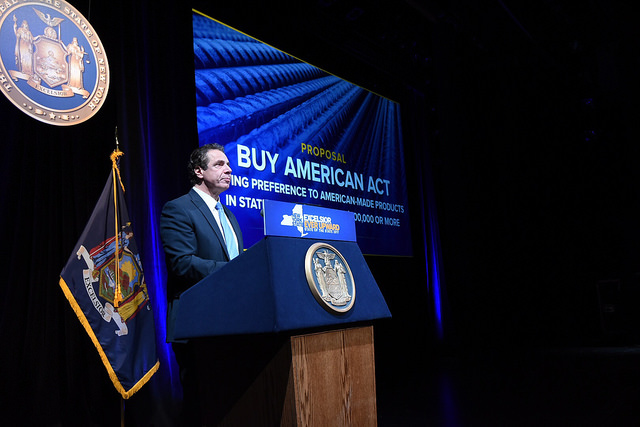
If implemented, Gov. Andrew Cuomo’s plan would be the nation’s strongest Buy America mandate.
Things in the nation’s capital right now are… interesting.
But in New York, state legislators from both parties are hard at work on an effort led by Democratic Gov. Andrew Cuomo to strengthen the Empire State’s Buy America preferences.
Under the proposal, which was first unveiled in Cuomo’s State of the State address on Jan. 11, Buy America preferences would apply to all new state procurements over $100,000. If implemented, this would be the nation’s “strongest mandate for the purchase of American-made products by state entities,” according to Cuomo.
Here’s Cuomo, talking about the proposal in his address:
New York is prepared to lead the way forward. When we Buy American, we not only keep our companies and our employees where they belong, but we foster growth and development in leading industries right here at home.
There’s already bipartisan support building for the proposal, too. Democratic Majority Leader Joseph Morelle introduced a Buy America bill in the state assembly, while Republican State Sen. Joseph Robach authored companion legislation that has been introduced in the state senate.
Expanding Buy America is critical to manufacturing workers and companies in New York. Right now, New York spends billions of taxpayer dollars each year on goods and services for government projects, but there are few guidelines in place to ensure all that money is reinvested to support American workers and manufacturers.
According to the governor’s office, manufacturing represents one in nine jobs in upstate New York — amounting to more than 5 percent of the state’s total workforce.
That’s one of the reasons why the proposal has earned support from New York leaders like Mario Cilento, president of the New York State AFL-CIO, who called the plan “noble” in a New York Daily News op-ed published on Wednesday.
“Without Buy American, state government uses your tax dollars to purchase foreign-made goods and materials,” Cilento said. “And too often, foreign companies are not competing on a level playing field. Benefiting from government ownership or subsidy and currency manipulation, they can dump products and materials at cut-rate prices.”
Cilento points to the renovation of the Verrazano Bridge as an example of what can go wrong when Buy America doesn’t apply to a project. The Metropolitan Transportation Authority outsourced the project to China, despite the fact that there were American workers ready and willing to do the project.
Compare that to the ongoing construction of the new Tappan Zee Bridge, which is using American-made steel. That project is being completed ahead of schedule, has saved more than $1.5 billion and has created thousands of U.S. jobs, Cilento noted.
“We have the most skilled workers in the world,” Cilento wrote. “We should be investing in them, not sending their jobs overseas.”
There’s widespread bipartisan support from the public on the issue as well. In New York, 82 percent of residents support giving a preference to American-made products in state procurement, according to the Siena Research Institute.
That jives with national polling following the presidential election, which found 79 percent of voters for now-President Donald Trump and 71 percent of voters for Democratic candidate Hillary Clinton supported Buy America preferences.
